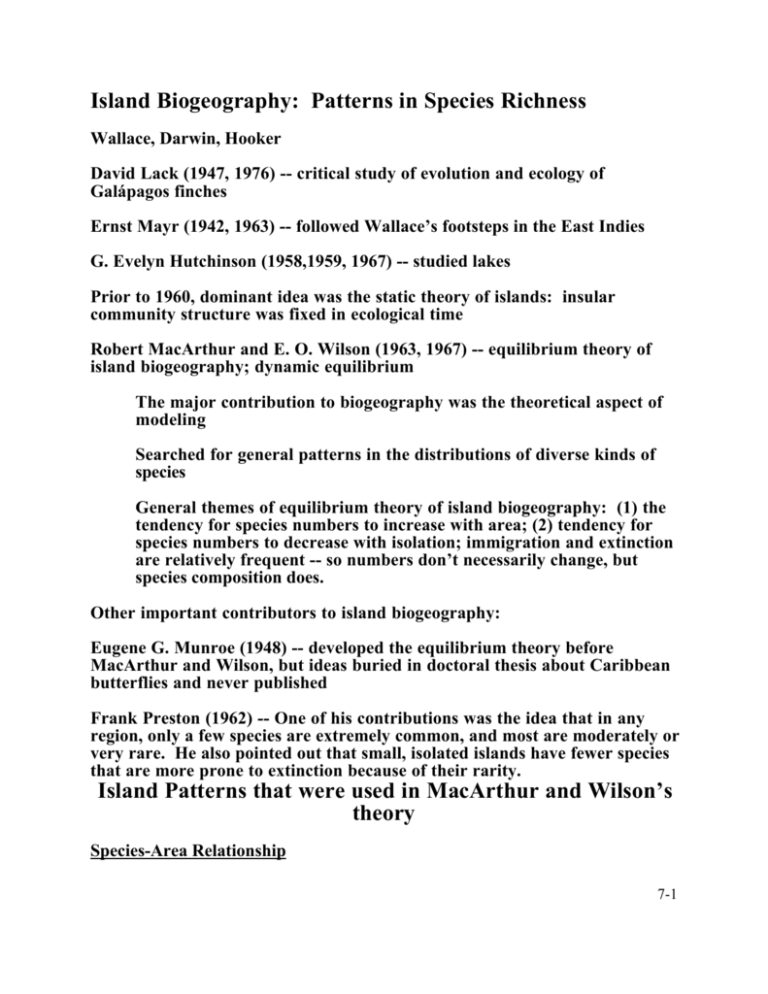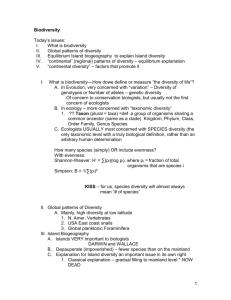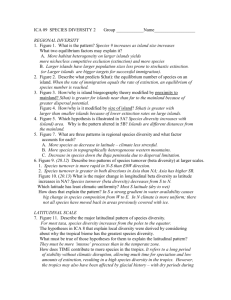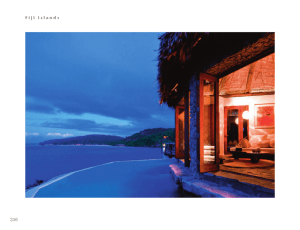Island Biogeography: Patterns in Species Richness Island Patterns
advertisement

Island Biogeography: Patterns in Species Richness Wallace, Darwin, Hooker David Lack (1947, 1976) -- critical study of evolution and ecology of Galápagos finches Ernst Mayr (1942, 1963) -- followed Wallace’s footsteps in the East Indies G. Evelyn Hutchinson (1958,1959, 1967) -- studied lakes Prior to 1960, dominant idea was the static theory of islands: insular community structure was fixed in ecological time Robert MacArthur and E. O. Wilson (1963, 1967) -- equilibrium theory of island biogeography; dynamic equilibrium The major contribution to biogeography was the theoretical aspect of modeling Searched for general patterns in the distributions of diverse kinds of species General themes of equilibrium theory of island biogeography: (1) the tendency for species numbers to increase with area; (2) tendency for species numbers to decrease with isolation; immigration and extinction are relatively frequent -- so numbers don’t necessarily change, but species composition does. Other important contributors to island biogeography: Eugene G. Munroe (1948) -- developed the equilibrium theory before MacArthur and Wilson, but ideas buried in doctoral thesis about Caribbean butterflies and never published Frank Preston (1962) -- One of his contributions was the idea that in any region, only a few species are extremely common, and most are moderately or very rare. He also pointed out that small, isolated islands have fewer species that are more prone to extinction because of their rarity. Island Patterns that were used in MacArthur and Wilson’s theory Species-Area Relationship 7-1 species numbers tends to increase with increasing area this relationship described mathematically by Arrhenius (1920) as S = cAz where S = species number A = island area c = fitted constant that depends on the taxon and biogeographic region; but most strongly on population density z = fitted parameter that represents the slope when both S and A are plotted on logarithmic scales; changes very little among taxa or within a given taxon in different parts of the world, but is correlated with elevation and proximity to the mainland log (S) = log (c) + z log(A) referred to as the “power model” Species-isolation relationship For a variety of taxa and ecosystems, species richness should decline as a negative exponential (sigmoidal function) of isolation Species Turnover number of species increases until saturation; spp go extinct and are replaced by others Equilibrium Theory of Island Biogeography Three basic characteristics: 1. species-area relationship 2. species-isolation relationship 3. species turnover 7-2 number of species inhabiting an island represents a dynamic equilibrium between opposing rates of immigration and extinction, which are recurrent. (Fig. 13.7) - simplest model The simplest model doesn’t accommodate island size or isolation (Fig. 13.8) - in this model, island size affects only extinction; isolation affects the immigration rate Bottom line: SLN > SLF ~ SSN > SSF where L = large, S = small, N = near, F = far Model also predicts this relationship among turnover rates: TSN > TSF ~ TLN > TLF Strengths and Weaknesses of Equilibrium Theory Strength of the theory lies in the simplicity of the model -- specifically that the model offered clear, testable predictions Weakness also lies in the simplicity of the model -- and these were pointed out by the authors lack of information about the precise shape of the extinction and immigration curves 7-3 artificial distinction between immigration and extinction assumption that extinction and immigration curves have fairly regular shapes for different faunas and different islands and for different times on the same island Concerns raised by others: many insular biotas may not be in equilibrium the model ignores interspecific interactions immigration and extinction are treated as independent processes it may be difficult to identify the source of an island biota speciation on islands violate the model area provides a coarse measure of an island’s ability to support a biota Tests of the model Estimates of turnover on landbridge islands Jared Diamond (1969) - examined turnover of birds on California Channel Islands A follow-up study by Jones and Diamond (1976) where Santa Catalina island censused several years in succession found year-to-year turnover. Others looked at other island systems and found human influence to have highest impact on species turnover. In other words, the support is not yet compelling 7-4 Turnover on recently created anthropogenic islands archipelagos created by flooding of mountainous areas in the tropics: Barro Colorado island in Lake Gatun; islands in Lago Guri. Surveys of both systems reveal that extinctions and immigrations appear to be recurrent. Thomas Schoener (1983) reviewed 21 studies of turnover -- revealed that turnover tends to be lower on larger islands and increases with generation time of the organisms = Support for the theory Experimental defaunation Wilson and Simberloff (1969, 1970) -- worked with mangrove islands in the Florida Keys. Did initial survey of arthropods, hired an exterminator to come in an kill all animals using methyl bromide (no harm to plants), and then monitored the islands. Recolonization was rapid. High rate of turnover noted, also. = strong support for the theory Other Patterns of Island Species Richness The rescue effect Study of insects and spiders growing on thistles plants growing in desert shrubland of southeastern Arizona (Brown and Kodric-Brown 1977). Proximity to a source of immigrants increases the immigration rate, and a continual influx of individuals within a species tends to prevent extinction. Rescue effect: high rates of immigration reduce the probability that a species will temporarily be absent and hence recorded as a turnover. Target area effect larger islands may serve as a more effective target areas for potential immigrants because they are more likely to be seen or encountered. Small island effect tendency of species richness of some insular faunas to remain relatively low and independent of areas for the smallest islands 7-5 Insular biotas that are not in equilibrium species numbers increasing or decreasing as a result of historical perturbation -- approaching a new equilibrium, rather than being in equilibrium Pleistocene refugia Habitat refugia Ecologists have attempted to apply the equilibrium theory to the design of nature reserves. Habitat fragmentation has a huge impact on species-area curves, immigration and extinction. Krakatau Observation of Rakata have supported much of the equilibrium theory but also highlighted limitations of the theory. Other Limitations of Island Biogeography Theory: MacArthur and Wilson anticipated that immigration and extinction curves may not be simple if major succession changes occur. Some species are strongly dependent on other pioneer species to create niches for them. Periodic Disturbance 7-6 Equilibrium may never be attained if ecosystems are constantly disturbed (hurricanes, fire, volcanic eruptions, etc). Speciation equilibrium model does not accommodate speciation. 7-7 Patterns in the Assembly and Evolution of Insular Communities Islands tend to be species-poor in comparison to mainland communities Structure of insular communities is strongly influenced by evolution in situ Harmonic biota - where island biotas are similar to source biota Disharmonic biota - biotas have major differences Selective nature of immigration species vary in traits affecting their immigration potential to the extent that interspecific differences are predictable, they will translate into predictable, nonrandom patterns of species distributions and community structure among islands. Establishing Insular Populations Good dispersers may be preadapted for successful colonization of islands r- strategists vs. K-strategists Selective nature of extinction islands should favor communities of good dispersers that require few resources. some types of species have become locally extinct much more frequently than 7-8 others; differences related to ecological characteristics Animals of larger size, carnivorous diet, or specialized habitat requirements more susceptible to extinction than species that are smaller, herbivorous, and generalized in habitat requirements body size and demography influence the ability of introduced birds to establish and maintain insular populations Extinction of Hawaiian birds influenced by habitat preference Patterns reflecting differential immigration and extinction Nestedness of insular communities Islands of archipelagos may have decreasing subsets of taxa as isolation increases Darlington’s (1957) graphical model for nestedness Distributions of particular species Metapopulation theory -- an attempt to estimate the proportion of islands (patches) that must be occupied to ensure the survival of the interacting populations of a species - its metapopulation. metapopulation models can be used to estimate the time to extinction probability or frequency of immigration decreases with increasing isolation 7-9 frequency of extinction decreases as island area increases minimal area requirements to maintain populations should increase as isolation increases Patterns reflecting interspecific interactions competition*, predation, parasitism, mutualism Predicted patterns: 1. ecologically similar species should exhibit mutually exclusive distributions, seldom if ever occurring together on the same island 2. conspecific populations on species-poor islands should exhibit relatively high densities 3. ecological release should be exhibited; characterized by significantly broader niches and shifts to other niches Some patterns of insular community structure appear to be so regular that Diamond termed them assembly rules Evolutionary Trends on Islands Flightlessness and reduced dispersal ability on islands Birds: derived flightlessness appears in eight orders of birds and most archipelagoes selective pressures associated with absence of predators and limited resources on islands -- ecological release moas, dodoes, solitaires, elephant birds 7-10 Insects: beetles, lepidopterans, flies, bees, orthoptera, homoptera some insects have lost power of flight and increased in size and have taken over the rodent niche in New Zealand (the wetas) selection pressure to remain in place Snails: small body size enables dispersal by wind; colonization by microsnails followed by evolution of large body size Plants: colonizers were good dispersers (some via wind); reduction in dispersability noted herbaceous forms on mainland evolve to secondary woodiness (tree forms common) -- represents ecological release Evolution of Body Size on Islands Gigantism: Ecological release can promote gigantism. Large size has a number of advantages: 1. Larger individuals can exploit a greater diversity of resources. 2. With sufficient resources, larger individuals can produce larger litters or clutches. 3. Larger individuals dominate in territorial disputes or in other competitive interactions. 4. Larger individuals have relatively greater energy and water reserves 7-11 that enable them to withstand famine and drought better than smaller individuals. Dwarfism: Resource limitation can promote dwarfism. Being small also has certain selective advantages: 1. Smaller individuals need fewer resources. 2. Smaller individuals tend to be more specialized and more efficient and assimilating nutrients and energy. 3. Smaller individuals can exploit small shelters and refugia from predators -- reduce impact of stressful environments. Insular mammals: Island Rule sensu J. Bristol Foster (1964): Different groups of mammals tend to exhibit different trends in insular body size. General trend -- dwarfism in large mainland taxa and gigantism in small mainland taxa Pygmy mammoth: once widespread across Malaysia, the Mediterranean, the California Channel and the Arctic Ocean. Birds and reptiles: Widely distributed on islands. Different families and orders exhibit different trends Gigantism common in iguanids, herbivorous lizards, whiptails, tiger snakes. Dwarfism common in rattlesnakes, rails, ducks 7-12 7-13 The Taxon Cycle E. O. Wilson (1959, 1961) proposed that insular species evolve through a series of stages from newly arrived colonists (mainland forms) to highly differentiated endemics, which ultimately go extinct. Stage I -- initial colonization and establishment Stage II -- differentiation of insular populations Stage III -- differentiation and range contraction continues, taxon may represent relictual endemic, highly specialized. Stage IV -- ranges of relictual endemic undergo further contraction; extreme specialization results in weak competitiveness to new species colonizing island; extinction. 7-14








